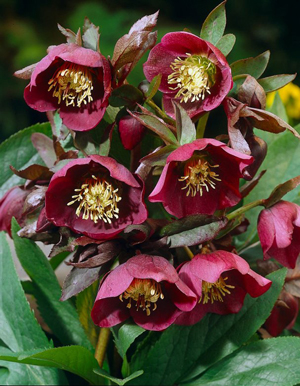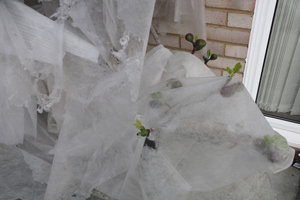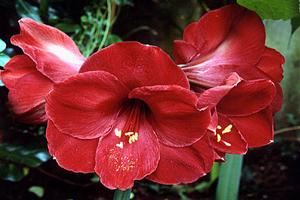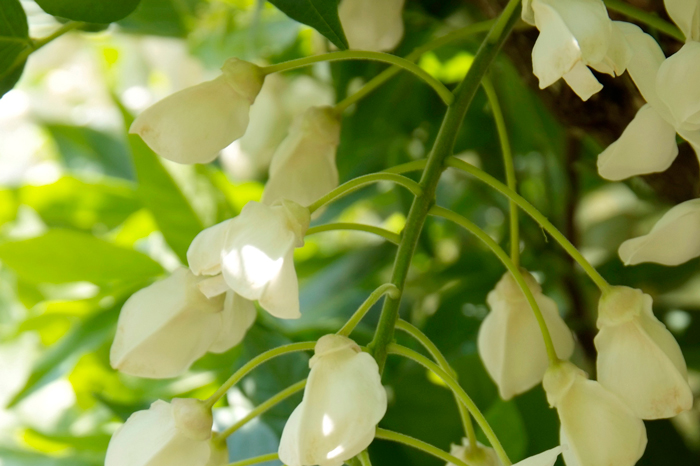January Garden Diary
Welcome to the January 2015 edition of our Garden Diary, written for us by Geoff Hodge, of The ScottsMiracle-Gro Company. Keep up-to-date with what needs doing in your garden with our month by month column.
There’s good news for those of you who like a traditional winter – not so good for those who prefer mild conditions! The early indications are that it will be a colder than average January with significant snow. The good news is that rain levels will be typical for the month – not higher. But it’s a month with something for everyone, with no weather pattern dominating for long.
Luckily, snow will insulate the soil – but its weight can cause damage to evergreens, so carefully knock off any heavy accumulations.
FLOWER BEDS & BORDERS
Summer-flowering bulbs, corms and tubers are one of the highlights of the summer. There are so many to choose from and they come in a rainbow of usually vibrant colours. What garden could do without begonias, cannas, dahlias, eucomis and gladioli – to mention just a few?
 Although most are not completely hardy and can’t be planted outside until after the main frosts in spring, buy or order them now to ensure good stocks of your favourite varieties. You can plant them up now in pots of good potting compost (such as Miracle-Gro Potting Mix Root Boosting Compost) and grow them on frost free in a greenhouse or frame for planting outside during late spring or early summer. This will provide an earlier display than planting directly outside after the frosts.
Although most are not completely hardy and can’t be planted outside until after the main frosts in spring, buy or order them now to ensure good stocks of your favourite varieties. You can plant them up now in pots of good potting compost (such as Miracle-Gro Potting Mix Root Boosting Compost) and grow them on frost free in a greenhouse or frame for planting outside during late spring or early summer. This will provide an earlier display than planting directly outside after the frosts.
Towards the end of the month you can start sowing seeds of annuals that need a long growing season – such as antirrhinum, begonia, geranium (pelargonium), lobelia and salvia. But only sow as long as you have the necessary warmth to grow the plants on (a minimum of 10C/50F), a brightly lit place (a greenhouse or conservatory are best) and the facilities to harden off the plants before planting out. Sowing too soon in the wrong conditions can lead to straggly, unhealthy plants that never perform well in the garden. Before sowing or potting up, make sure that the compost has been warmed to room temperature; cold compost will prevent seed germination and lead to rotting. (pictured above left: Helleborus orientalis).
If you missed out on planting spring-flowering bulbs in autumn, don’t worry as you can buy potted bulbs now. Good garden centres and nurseries should have plenty to choose from at this time of year.
Topical tip
Remove the old leaves from hellebores, particularly H. niger – Christmas rose, to make the new blooms more visible as they emerge. This will also help prevent the spread of hellebore leaf spot disease.
LAWNS
Watch out for signs of waterlogging during periods of very wet weather. Spiking the lawn with a garden fork or using a hollow-tine aerator may remedy this. In severe cases, especially on compacted clay soils, you may have to improve the drainage with a permanent solution – such as digging a sump for water to drain into or even installing drains.
If the weather is mild, and the lawn isn’t frozen or waterlogged, you can repair bumps and hollows. Make an H-shaped cut in the turf with a half-moon edging iron, peel back the resulting flaps of turf, then either fill the hollow with soil or EverGreen Enriched Lawn Soil, or scrape away the excess soil from a bump. Re-lay the turf flaps and press them back into place.
Topical Tip
You can also cut the lawn edges with lawn edging shears to prevent creeping grasses growing into borders.
GROW YOUR OWN
Vegetables
It’s important to know the pH (acidity/alkalinity) of your soil – particularly when it comes to growing some vegetables: peas, beans and brassicas prefer an alkaline soil; potatoes prefer an acidic soil, as they are more prone to potato scab disease in alkaline soil. And now’s a good time to test it. Soil pH testing kits and pH meters come in numerous forms and are inexpensive to buy and a worthwhile investment. While you’re testing for pH, go the whole hog and test the nitrogen, phosphorous and potash levels too. Having this knowledge may well solve those long-term niggling questions about why your plants have been struggling to grow!
Garden centres will have their stocks of seed potatoes and onion sets. Although it’s too early to plant them outside, go and buy them now as you’ll have the best selection of varieties. Most shops stock ‘taster bags’ – a few tubers of a variety, so you buy a few different ones and so can grow a wider range of varieties – even in small spaces or in containers or potato sacs on the patio.
Topical tip
If you fancy some freshly grown salads, you can grow them on a brightly lit windowsill or other place indoors. Good choices include cut-and-come-again lettuce and other salad leaves.
Fruit
 In cold regions, you may need to provide winter protection for wall-trained figs to help the young figs overwinter to produce this year’s crop. Cover with plastic netting and fill between the plant and the netting with straw, bracken or other open insulating material. This covering should remain on until the danger of frost has passed.
In cold regions, you may need to provide winter protection for wall-trained figs to help the young figs overwinter to produce this year’s crop. Cover with plastic netting and fill between the plant and the netting with straw, bracken or other open insulating material. This covering should remain on until the danger of frost has passed.
Free-standing and container-grown figs can be covered with horticultural fleece when cold weather and frost are forecast. In very cold weather, it also pays to protect peaches, nectarines and apricots.
Clean up old strawberry beds, removing yellow foliage, old runners and any plants that look as if they are affected by viruses.
Lift and pot up or plant out rooted strawberry runners. These will make new plants to fruit for the next five to six years and are useful replacements for old or diseased plants.
Forcing rhubarb is a great way to get an early crop of young, succulent stems. First clear around the base of the plant to remove old, dying or damaged leaves. Then cover the plant with a large pot, decorative rhubarb forcer or even an old dustbin. Make sure any holes are covered up to exclude light. To speed forcing, you can insulate inside and outside of the cover with a thick layer of straw or partly cover the crown with manure.
Topical tip
As long as the soil isn’t frozen solid or waterlogged, keep planting new fruit trees, bushes and canes. This is a great time of year to restock the fruit garden.
TREES, SHRUBS, ROSES & CLIMBERS
Continue to plant hardy trees, shrubs, climbers, roses and hedges, as long as the soil isn’t frozen solid or waterlogged. At this time of year you may be able to get your hands on bare-root or rootballed plants. These are cheaper than containerised ones, so a better option when you have a lot of planting to do – such as a new rose bed or hedge.
Ensure your wisterias flower profusely this year by cutting back all sideshoots to 2.5-5cm (1-2in) long, except where you need to extend the main framework of branches to cover the support.
This is a good time to train climbers to provide good, even coverage of their supports. Carefully guide the stems in the direction you need them to grow. Then carefully tie them in with string or similar soft material.
Wherever feasible, try to tie in the stems horizontally or as near to horizontal as possible – or, if more suitable, into a fan shape. This reduces the leafy, vegetative growth and, as a result, encourages more flowers.
Topical tip
Check tree ties and stakes are still firmly in place and providing support. Stakes can usually be removed after two to three years, once the tree has established.
GENERAL GARDENING JOBS
Get ready for the main spring seed-sowing season by cleaning all your old small pots and seed trays, so you can re-use them. You can clean them with household bleach (read the safety information on the label before use), but make sure you rinse them thoroughly afterwards. Thorough cleaning will reduce possible pest and disease problems troubling the young plants and seedlings.
Patio slabs and wooden decking can become extremely slippery and dangerous during wet weather. Treating them with a suitable cleaner will also remove moss and lichens, to reduce the risk, as well as making them look far more attractive. Patio Magic! can be used on all outdoor hard surfaces. It is easy to use – just dilute and apply – there’s no scrubbing needed.
During mild weather, weeds will still appear in bare areas of soil. The best method of control at this time of year is to hoe regularly with a sharp hoe to keep them in check.
Topical tip
As outdoor water taps can be severely damaged by freezing weather, make sure, wherever possible, to cut off the water supply and drain the tap. Insulating taps with lagging is also a good idea.
HOUSEPLANTS
The winter can be a stressful time for houseplants, so give them the care they need to ensure they look their best. Check them regularly to see if they need watering or misting and look for any pest problems.
Make sure you don’t overwater plants – this is the commonest reason for them dying. And make sure you use tepid water – cold water straight from the tap can damage the roots of many houseplants.
Only feed houseplants that are in flower. Miracle-Gro Pour & Feed is the easy way to feed houseplants.
Stand foliage houseplants on trays of damp gravel or hydroleca to counteract the drop in humidity from the central heating. Misting the foliage with a hand mister and grouping them together also helps to create a humid atmosphere.
 Like most bulbs, the main time to give amaryllis lots of TLC is after flowering. This is when the bulb is building up its strength and producing next year’s flower buds. After flowering, carefully remove the faded flowers and developing seed pods. Keep the plant actively growing for as long as possible by keeping the compost evenly moist and regularly feeding with Miracle-Gro Pour & Feed or other liquid Miracle-Gro feed. Don’t cut off or remove the leaves until they naturally turn yellow and start to die – they are needed to build up the bulb’s food reserves and develop the flower buds. Then reduce the watering and stop feeding.
Like most bulbs, the main time to give amaryllis lots of TLC is after flowering. This is when the bulb is building up its strength and producing next year’s flower buds. After flowering, carefully remove the faded flowers and developing seed pods. Keep the plant actively growing for as long as possible by keeping the compost evenly moist and regularly feeding with Miracle-Gro Pour & Feed or other liquid Miracle-Gro feed. Don’t cut off or remove the leaves until they naturally turn yellow and start to die – they are needed to build up the bulb’s food reserves and develop the flower buds. Then reduce the watering and stop feeding.
Once the bulb has lost its leaves and gone dormant, put it somewhere cool and keep the compost dry until you’re ready to bring it back into growth next autumn.
Cacti and succulents, apart from Christmas cacti, need a period of cool dormancy over the winter: keep them at 7-13C (45-55F), the compost barely moist and don’t feed. Resume normal care in spring to bring them back into growth and flowering. Clivias also benefit from a rest period over winter.
If your Christmas cactus failed to set flower buds, it may be that the temperature is too high (above 18C/65F), or that the plant is receiving light from an artificial light source after dark. Try moving plants into cooler conditions or away from night lighting.
Topical tip
Give foliage houseplants a break from the dull winter indoor light by moving them nearer to windows or to a conservatory for a few weeks.
Use plant protection products & biocides safely. Always read the label and product information before use. Pay attention to the risk indications and follow the safety precautions on the label.
Patio Magic!® contains benzalkonium chloride.
Products marked ® and ™ are trademarks of The Scotts Company LLC or its subsidiaries.



